The owner of a private house needs to take into account many factors from the very beginning of construction to the complete readiness of the home. If you have your own home, then you probably got into situations where you had to plan or redo communications. An important point can be missed even when working with a master. For example, frozen condensate in ventilation in a private house or on the roof of an MKD will soon weaken the draft, up to a complete stop of air exchange.
During cold seasons, moisture can accumulate in excess and destroy materials. Ventilation in a large house cannot be remodeled in one day, but thanks to the article, you will learn all the nuances and be ready for renovation. You will not make mistakes, save time and money. We will tell you about the features of condensate and methods for its elimination.
Condensation occurs due to mechanical problems with ventilation and certain external conditions. There are many options for how to get rid of it, and three ways with a more thorough approach. From the article you will understand which method will be more convenient and justified for you.
The content of the article:
- Reasons for the accumulation of condensate
-
How to get rid of condensation in ventilation?
- Method # 1. Correct and high-quality thermal insulation
- Method # 2. Forced ventilation
- Method # 3. Changing the pattern of the outdoor duct
- Conclusions and useful video on the topic
Reasons for the accumulation of condensate
Condensation occurs due to external factors, with poor ventilation conditions. Installers sometimes make mistakes and the system is weak. Condensation also builds up due to high humidity in the house.
Excessive humidity in the room will be indicated by drops on the inside of the windows. In summer, only frequent ventilation is needed, and there will be no moisture in the pipes. In cool weather, the air liquefies on the walls of the air channels, primarily at the junction of heat and cold.
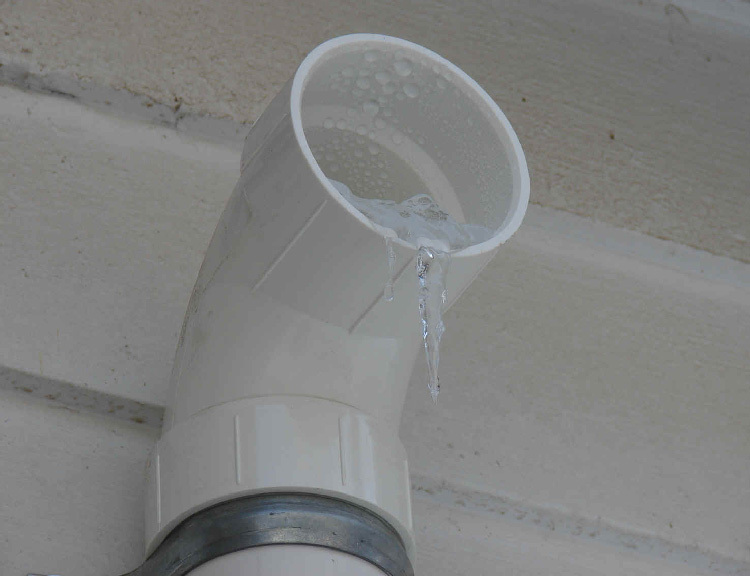
In the cold season, the condensate in the head freezes and turns into icicles. It will have to be removed from the pipe with a stick or by hand
Other causes of condensation:
- ventilation leaks;
- destruction of the pipe from the side of the street;
- the proximity of the channels to the outer wall;
- the pipes were not insulated;
- insufficient wall insulation;
- temperature drops in the building / outside;
- icing at home;
- basement water;
- the house was built on a damp foundation;
- there is a leak in the water supply.
Condensate ventilation ducts will gradually fill with harmful microorganisms. It will be difficult to remove them from there, and in addition there will be an unpleasant odor and the likelihood of getting sick.
Ventilation pipes need cleaning. Insects, spiders, leaves get there. Birds build nests in the inlets. Due to the weakening of the draft, condensation is formed in an even greater amount. It does not hurt to check the strength of the inflow / outflow of air with a sheet of paper or a lighted match. Improper circulation also reduces cravings.
In winter, the outer outlet can freeze completely, and if you do not control this moment, there will be an excess of moisture on the walls and ceilings, and the finish will deteriorate.
Condensation is also caused by large bodies of water nearby. Sometimes the tenants themselves are to blame - if they dry their clothes indoors.
How to get rid of condensation in ventilation?
Condensation is the transition of a gas or saturated vapor to moisture. Sometimes this is called transformation immediately into a solid (desublimation). In severe frost, moisture at the ventilation head quickly turns into ice.
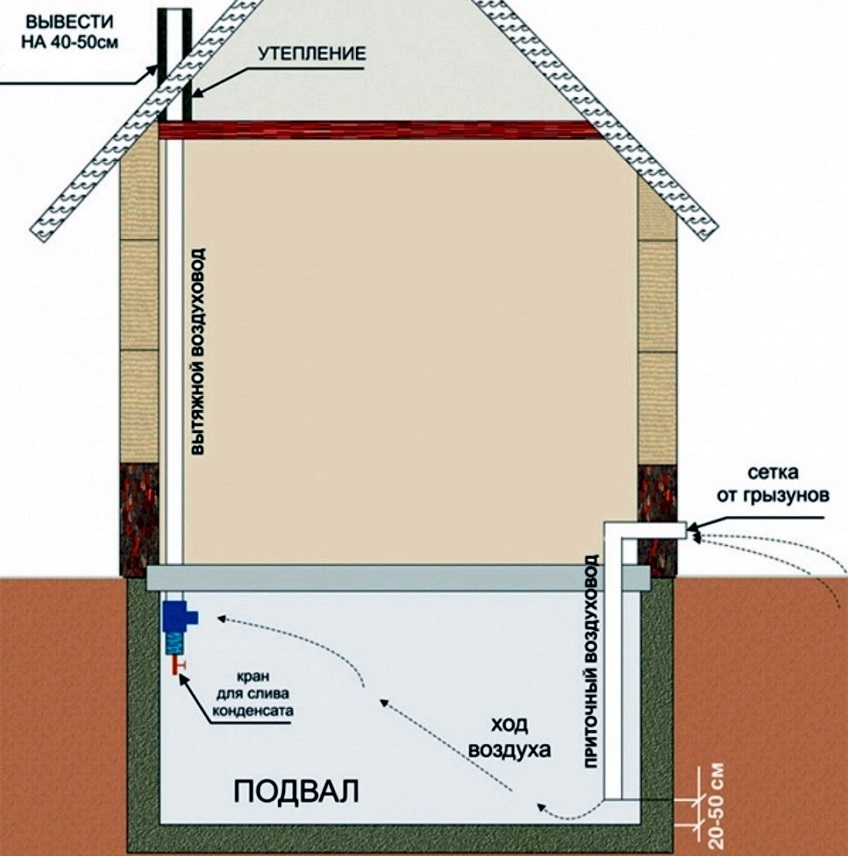
The picture shows a classic drawing of the ventilation of a private house: a short air duct on the roof, thermal insulation above the ceiling of the upper residential floor, condensate drainage into the basement - this has both advantages and minuses
It is easier for residents of private buildings to solve the problem: it is easier to find the necessary conclusions, no one forbids changing ventilation, and special permits are not needed. Thanks to new ventilation pipes condensation in private houses appears later than in old high-rise buildings, under the same conditions.
In the case of low traffic, the channels are cleaned with a pipe brush. When depressurizing, you will have to look for a hole. Humidity rises due to unbalanced air exchange. In private houses, there are more rooms, and the ventilation system should be laid with a powerful one. If it is already working, and replacement is undesirable or difficult, it remains to stimulate the removal of moist air and the supply of fresh air instead.
The complete absence of moisture and ice in ventilation and a stable result are given by three methods:
- Reliable thermal insulation (insulation).
- Forced ventilation.
- Changing the pattern of the external duct - to drain moisture into the condensate trap.
With the second and third methods, thermal insulation will bring additional benefits. Keep in mind that in the first and third options, you need to work with all organized natural ventilation: its supply, exhaust and supply and exhaust ducts.
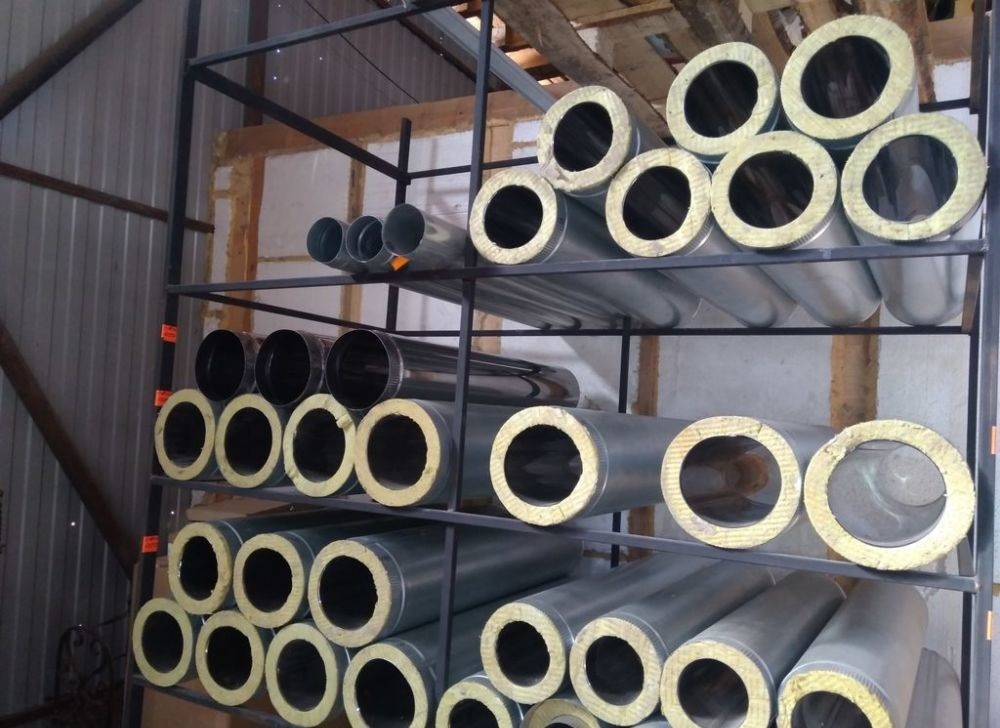
At the design stage, there is a choice: buy sandwich pipes with a layer of thermal insulation under the top cover or purchase insulation for individual parts. Now there are many materials that exactly follow the bends of ventilation elements - crosses, tees and others.
Sometimes it is necessary to replace damaged or old ventilation elements. In the worst case, be prepared to install a new system and plug the old one. The problem cannot be ignored if there is always a lot of moisture in the attic.
Method # 1. Correct and high-quality thermal insulation
It is worth insulating first of all in places with the greatest temperature difference. Thermal insulation is needed for ducts near the ceiling of the upper floor, in the attic and on the roof. They are insulated in that order, and then insulated below, if a temperature contrast is also possible there.
Supply systems are ideally insulated not only through pipes, but also through valves. After arranging the problematic part of the ventilation, it will be possible to save on the rest.
The following heaters are suitable:
- polyethylene foam;
- expanded polypropylene;
- expanded polystyrene;
- mineral wool;
- glass wool.
Mineral wool reliably protects from the cold, but quickly deteriorates from moisture and partially loses its properties. Only a layer of waterproofing will help. Glass wool is stronger than ordinary mineral wool, but otherwise it is almost the same.
Polyethylene foam has good moisture resistance, low weight. Similar qualities are observed in polypropylene foam. Foamed polystyrene (expanded polystyrene) almost does not allow steam to pass through, which is considered a plus in modern design for heat retention.
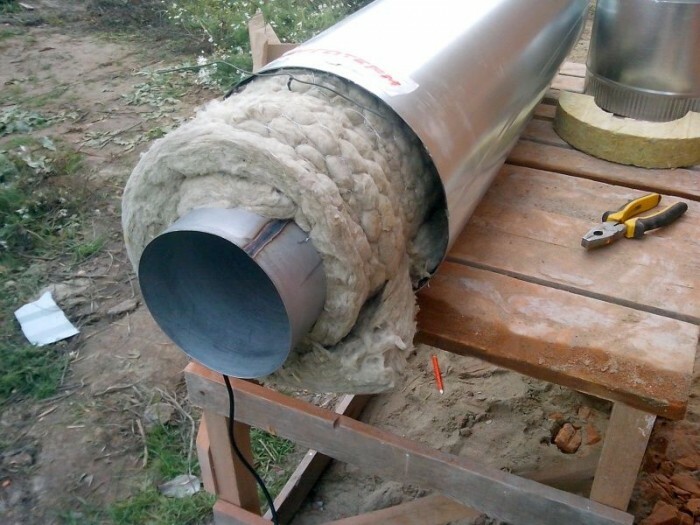
Mineral wool should be pre-cleaned of dirt, foreign inclusions and rust, then fixed with glue, tape and screeds and covered with roofing material or glassine on top to protect it from moisture
Phased pipe insulation:
- We wipe the channels, remove all moisture.
- We wind the heat-insulating material onto the pipes. We start with the channels of the top of the building and problem areas. We fix it with tape. We lay the adhesive tape longitudinally and additionally wrap it in transverse segments with a small interval.
- We achieve maximum tightness at the joints of the insulation and pipes.
- Cylindrical gaskets are also suitable for circular ducts. We cut them on one side. Then we glue and secure with tape.
- You can not leave a gap with air. Condensation can also form there, and it will spoil the thermal insulation. This will also lead to corrosion.
The distance between some pipes is inconvenient for insulation, so it is closed up. Suspended formwork is installed there, after which the space is filled with cement mortar. In places where ventilation goes behind the brickwork, it is worth sealing the seams more tightly, isolating the cracks. The above will not fully protect from the cold, but the main thing is that cold air will not come to the pipes and will not cause condensation.
After the correct work Dew point moves outside the ventilation. And as soon as you eliminate the condensation, the humidity will drop dramatically: in the case of ventilation in a private house, the changes will be significant - up to 60% or less.
It is not necessary to insulate narrow corrugated pipes made of malleable metals. They are replaced with plastic ones.
Warming will solve other issues at the same time. Fire safety will increase. Heat loss will decrease. The owners will not be disturbed by the noise in the ventilation ducts.
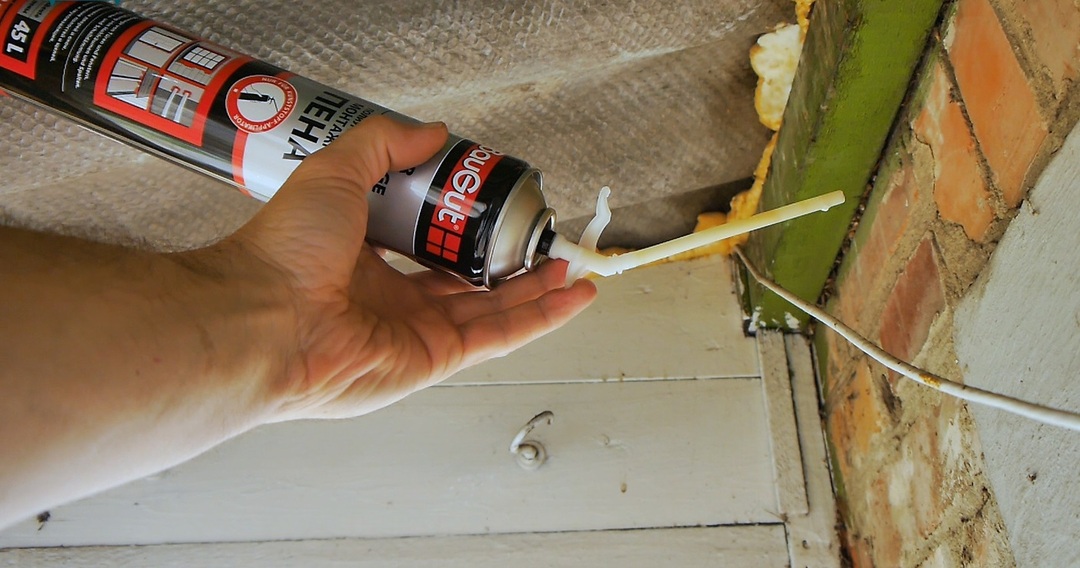
Stamp any joints and crevices in the upper part of the house, apply the product gradually in several layers and use the small-diameter attachments.
The thickness of the insulation should be selected based on all needs at once. To get rid of condensation is guaranteed, the outer part of the ventilation is protected with a heater with a thickness of 50 mm, and better - from 100 mm. The pipe head is equipped deflector.
Method # 2. Forced ventilation
Its arrangement begins with the kitchen. An exhaust fan is installed there. Old natural ventilation is left or closed with a plug. The new device is sometimes mounted in a window leaf, instead of a window leaf or a large sash.
A more comfortable option may be the option of an exhaust system in the wall or in a pipe that goes from the room to the street. The hole for the outlet is made either far from the outer part of the chimney, or slightly lower.
The exhaust system from the street is equipped with check valves. Appliances look like attachments. There is a flat version with a film partition. The film bends outward and lets warm air out of the house, but prevents cold air from entering, even in strong winds.
There are valves with a plastic baffle, which slightly scrolls along its axis, but only when exposed to the inside. With a greater thickness, such a device is less tight.
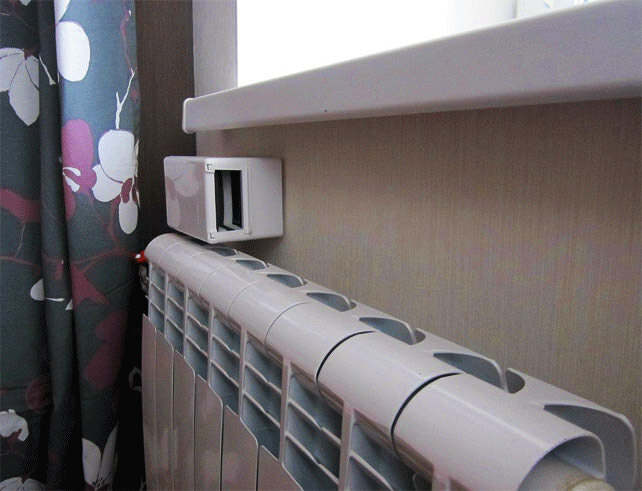
The supply valve above the battery is placed so that the center of the street opening is 60-80 millimeters above it and just as much below the window sill
For the intake of air from the street, they organize supply valve. It is placed next to a battery or other heating element and adjusted if necessary. The house will still be warm, and almost all the condensation will be removed from the ventilation.
The best material for an external forced ventilation pipe is plastic.
Method # 3. Changing the pattern of the outdoor duct
Consider an option where the outer part of the ventilation exits the building horizontally and has an upward bend. Then the ventilation pipe is divided at the fold. Be sure to at the lowest point - keep this in mind if the drawing is more complex.
A tee is fixed in the resulting hole. The sawn-off part is placed in the upper pipe, and the lower one is closed with a plug-cone (condensate collector). Dripping condensate will come out through it. This method is also called condensate drainage. The resulting system is insulated. This reduces the likelihood of freezing of the branch during prolonged frost.
On the condensate trap, you can attach a pipe to drain the liquid, and direct the free end into a bucket. This is done if the collection is in a hard-to-reach place. Sometimes they get by with only one bucket or organize a drain into the sewer. With a moderate amount of moisture, absorbent material is placed in the filtration zone. The cassette with it has to be removed and dried frequently.
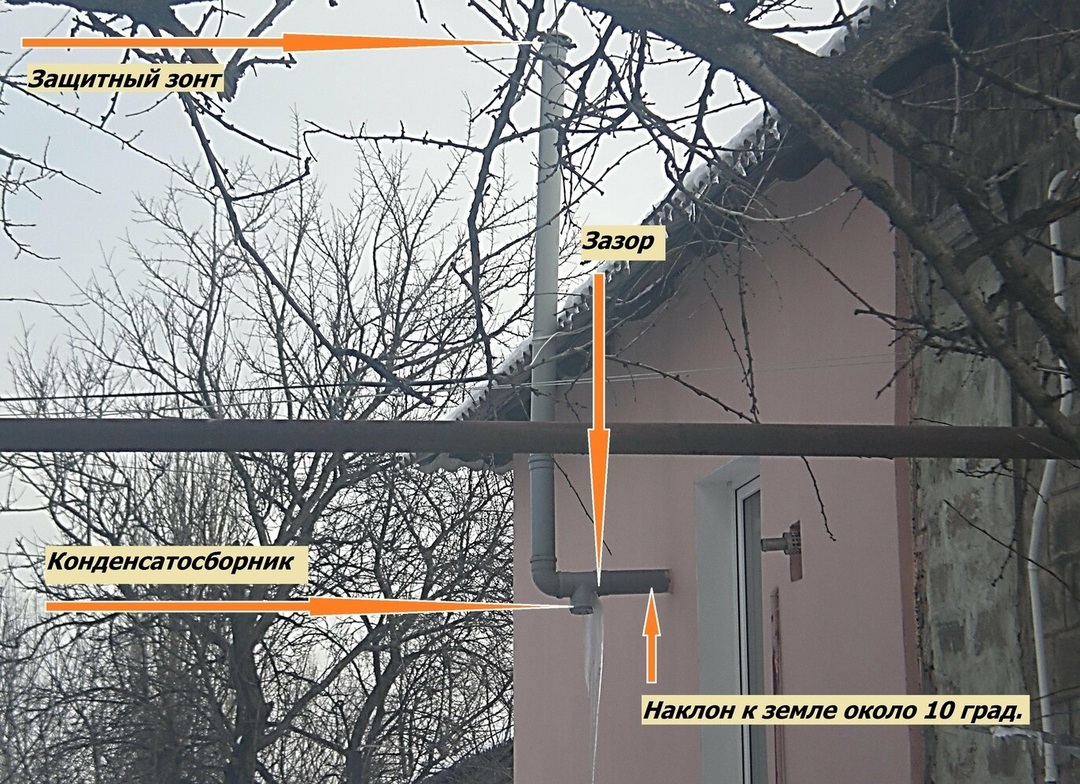
Option of placing the condensate trap on a bent pipe without installing a tee. This is only permissible when the outlet channel is inclined downward and at the lowest point.
The conical shape of the plug has an advantage over the flat one, in which water stands and almost does not flow out, despite the holes. The liquid is drained from the latter manually.
In winter, the situation changes a little - icicles appear and they cover a large area on the cone. The air from the house melts the ice a few days after a hard frost, and they fall. The length of the lower pipe of the tee is sufficient so that during this time the water does not reach the branching level. Watch for ice formation and, if necessary, knock it down yourself with a stick.
In a house with ventilation that has not yet been laid or not completely finished, it makes sense to make a side exit across the pediment. The task of self-laying will become easier than the idea of drilling a hole in the roof slope. Do not use this option if the pipe runs far from the gable.
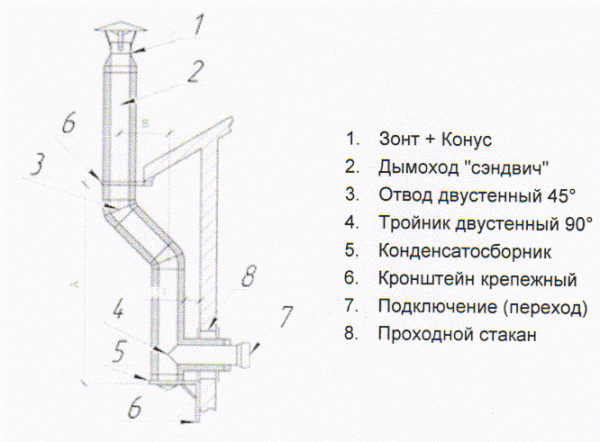
A pipe scheme with several bends and a tee to drain moisture, which is useful for houses with large eaves
A bend with a long channel after it will noticeably reduce traction. On the other hand, the rooms below will get better protection against moisture penetration.
If the outer part of the ventilation goes only horizontally, then it can be cut into it in any area. In a strictly vertical pipe, as in a curved one, they look for the lowest point. From a flat vertical channel, the drain usually goes into the house.
Conclusions and useful video on the topic
Insulation of ventilation with mineral wool in order to eliminate moisture is a good example:
Sewer pipe as a ventilation pipe, with a special channel for condensate:
Excess moisture in ventilation is eliminated in several ways. To do this, the pipes are repaired and cleaned, they are insulated or an additional ventilation system is installed. If you live in a private house, then in order to drain condensate from the ventilation, you can change the structure of the pipes in any way. Sometimes the system is completely altered, replaced with a new one. If in your case there were few negative factors, then the state of ventilation will allow you to maintain it.
Ask questions and write comments about ventilation in your home. Tell us about her condition and effectiveness. Perhaps your information will be of interest to other users. The contact form is located below.


